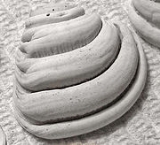
Imperial venus
Encyclopedia
The imperial venus clam, Chione latilirata, is a bivalve mollusc in the family
Veneridae
. It grows to about 4.5 cm (1.5 inches), and lives off the eastern shores of North
and South America
, south of Cape Hatteras
, in 20 to 40 m (60 to 120 ft) depths. Occasionally it is found washed up on ocean shores. It ranges from North Carolina
to Brazil
. This species has been frequently found among catches of the Atlantic calico scallop
.
 Its shell is rounded, triangular and well-inflated with large, heavy concentric
Its shell is rounded, triangular and well-inflated with large, heavy concentric
ridges and often sharply shelved at the top. Its ridges become fragile on dry specimens. Cardinal and lateral teeth are located on its hinge. Its coloration varies, but often has a tan exterior with lavender blotches and radial stripes.
Imperial venus are of the family Veneridae
which contains over four hundred known species, though not to the genus Venus
which contains the venus clams in the strictest sense. Species vary in shape from circular to triangular. Veneridae colonize the sand
y ocean bottom, and their populations are often dense and large.
The Veneroida
order typically have a folded gill
structure which is well developed for filtering out small food particles.
Family (biology)
In biological classification, family is* a taxonomic rank. Other well-known ranks are life, domain, kingdom, phylum, class, order, genus, and species, with family fitting between order and genus. As for the other well-known ranks, there is the option of an immediately lower rank, indicated by the...
Veneridae
Veneridae
The Veneridae or venerids, also known as the Venus clams, are a very large family of minute to large, saltwater clams, marine bivalve molluscs. There are over 500 living species of venerid bivalves, most of which are edible, and many of which are exploited as a food source.Many of the most...
. It grows to about 4.5 cm (1.5 inches), and lives off the eastern shores of North
North America
North America is a continent wholly within the Northern Hemisphere and almost wholly within the Western Hemisphere. It is also considered a northern subcontinent of the Americas...
and South America
South America
South America is a continent situated in the Western Hemisphere, mostly in the Southern Hemisphere, with a relatively small portion in the Northern Hemisphere. The continent is also considered a subcontinent of the Americas. It is bordered on the west by the Pacific Ocean and on the north and east...
, south of Cape Hatteras
Cape Hatteras
Cape Hatteras is a cape on the coast of North Carolina. It is the point that protrudes the farthest to the southeast along the northeast-to-southwest line of the Atlantic coast of North America...
, in 20 to 40 m (60 to 120 ft) depths. Occasionally it is found washed up on ocean shores. It ranges from North Carolina
North Carolina
North Carolina is a state located in the southeastern United States. The state borders South Carolina and Georgia to the south, Tennessee to the west and Virginia to the north. North Carolina contains 100 counties. Its capital is Raleigh, and its largest city is Charlotte...
to Brazil
Brazil
Brazil , officially the Federative Republic of Brazil , is the largest country in South America. It is the world's fifth largest country, both by geographical area and by population with over 192 million people...
. This species has been frequently found among catches of the Atlantic calico scallop
Atlantic calico scallop
The Atlantic calico scallop, Argopecten gibbus, is a species of medium-sized edible saltwater clam, specifically a scallop, a marine bivalve mollusk in the family Pectinidae, the scallops....
.

Concentric
Concentric objects share the same center, axis or origin with one inside the other. Circles, tubes, cylindrical shafts, disks, and spheres may be concentric to one another...
ridges and often sharply shelved at the top. Its ridges become fragile on dry specimens. Cardinal and lateral teeth are located on its hinge. Its coloration varies, but often has a tan exterior with lavender blotches and radial stripes.
Imperial venus are of the family Veneridae
Veneridae
The Veneridae or venerids, also known as the Venus clams, are a very large family of minute to large, saltwater clams, marine bivalve molluscs. There are over 500 living species of venerid bivalves, most of which are edible, and many of which are exploited as a food source.Many of the most...
which contains over four hundred known species, though not to the genus Venus
Venus (genus)
Venus is a genus of small to large saltwater clams in the family Veneridae, which is sometimes known as the Venus clams and their relatives. These are marine bivalve molluscs....
which contains the venus clams in the strictest sense. Species vary in shape from circular to triangular. Veneridae colonize the sand
Sand
Sand is a naturally occurring granular material composed of finely divided rock and mineral particles.The composition of sand is highly variable, depending on the local rock sources and conditions, but the most common constituent of sand in inland continental settings and non-tropical coastal...
y ocean bottom, and their populations are often dense and large.
The Veneroida
Veneroida
The Veneroida or veneroids are an order of bivalve molluscs. They include some familiar forms such as saltwater clams and cockles, and a number of freshwater bivalves including zebra mussels....
order typically have a folded gill
Gill
A gill is a respiratory organ found in many aquatic organisms that extracts dissolved oxygen from water, afterward excreting carbon dioxide. The gills of some species such as hermit crabs have adapted to allow respiration on land provided they are kept moist...
structure which is well developed for filtering out small food particles.

